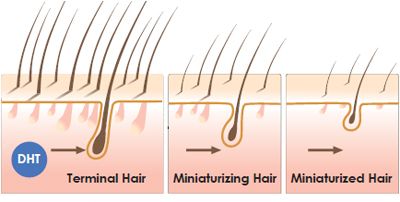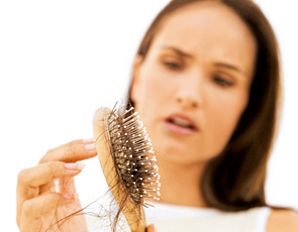
If you have the suspicion that you are going bald, you would likely want to know just what precisely is “happening under the hood.” Unfortunately, there is a sea of rumors that attempt to get to the “root” of the problem. After all, the great Hippocrates, father of modern medicine, thought that baldness could be cured by a blend containing horseradish and pigeon droppings. The wish to have a simple solution under our control is understandable. But let’s debunk the top 10 hair loss myths and learn what the facts really are.
Fact: Although the inheritance from the mother’s side is slightly stronger, androgenetic hair loss (common baldness) can be inherited from the mother’s side of the family, the father’s side –- or both.
Fact: This myth falls into the same category as the “size of a man’s hands or feet…” Hair loss is caused by a greater sensitivity of hair follicles in some parts of the scalp to DHT (dihydrotestosterone), and not to increased levels of testosterone as such. DHT causes genetically susceptible hair follicles to shrink (miniaturize) and eventually vanish. If high levels of testosterone were the problem, then all of ones body hair should be expected to fall out as well. Read more about hair loss in men and about hair growth cycles.

Fact: In contrast to popular belief, going bald is not because of large amounts of hair falling out, but rather by hair of normal thickness gradually being replaced by finer, thinner hairs -– a process called “miniaturization.” If large patches of hair start suddenly falling out, it is time to see your doctor.
Fact: When your hair is growing, it does require a a lot of blood flow. Once you lose your hair, not as much blood is needed and the blood flow to the scalp decreases. Therefore, a decreased blood flow to the scalp is not the reason for hair loss, but a result of it.

Fact: People who accuse their hats as being the reason of their hair loss think that wearing hats all the time keeps the scalp from breathing. Actually, hair follicles get oxygen from the blood stream, and not from the air.
Fact: Clogged pores are actually the reason for acne, not baldness. If common baldness were just due to clogged pores, then thorough shampooing would be all that was needed to maintain a full head of hair. This is clearly not the case.

Fact: When people's hair start to thin they sometimes think that shampooing is the reason, since they see hair in the tub. To prevent this, they begin to shampoo less frequently. The hair that would typically be washed out in the shower now builds up on the scalp. During the next shampoo, even more ends up in the tub, confirming the patient’s suspicion. Remember that hereditary baldness is not due to hair falling out, but rather by normal hair gradually being replaced by finer, thinner hairs. The simple solution is to shampoo every day and the excess hair in the tub will go away.

Fact: Balding is commonly considered a “man’s” issue, but the fact is that over 40% of women suffer from significant thinning throughout their lifetime. Read more about hair loss in women.
Fact: The main benefit of Rogaine (minoxidil) and especially Propecia (finasteride) is to slow down or halt hair loss, and not to re-grow hair. Although initial studies showing the effectiveness of both Rogaine and Propecia were done on the crown, this does not mean that the medications doesn’t work on other parts of the scalp as well. In fact, the medicines can work wherever there is thinning hair –- as long as the area is not completely bald. Read more about available medications.

Fact: Once hair loss begins, it tends to advance over a person’s lifetime and never totally stops. However, the rate at which hair will continue to fall out is difficult to guess. It is worth mentioning that the younger you are when you start losing your hair, the more likely you are to become very bald.

If you are suffering from slow or rapid hair loss and your hair thinning is becoming noticeable, or if you have balding that you wish to cover with new hair growth, we invite you to contact our hair restoration service today. You can find the answers to the most frequently asked questions here. Your doctors in Korea will provide a comprehensive medical and hair loss history, and scalp and hair analysis that will allow them to provide each patient with an accurate diagnosis so that a patient-specific treatment plan can be put into action. Contact us now.

Please send us your email address, and one of our representatives will personally contact you as soon as possible.
Your email address will never be sold or spammed.